Summing up any automotive brand in a few words isn’t easy, but if I had to explain Lincoln vehicles briefly, I’d start with understated elegance and a smooth ride. That’s certainly the case with the 2016 Lincoln MKC.
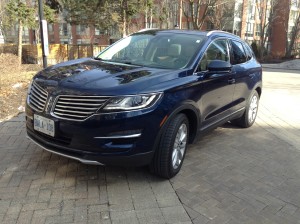
First impressions
The unitized welded steel body on my Midnight Sapphire Metallic tester offers a handsome profile, flowing from the signature Lincoln “split-wing” grille all the way back to the hands-free liftgate above chrome dual exhaust tips.
When the fob-bearing owner approaches the MKC, Lincoln “welcome mats” appear on both sides of the vehicle, thanks to lights embedded on the underside of the side mirrors. This same system also triggers “Intelligent Access” (i.e. no key required to enter the vehicle).
Interior
When I opened the MKC’s door, I was greeted with White Sands/Espresso colours on the leather trim and wood accents.
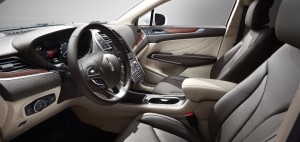
photo courtesy Lincoln
After making minimal adjustments to the power seat and mirrors, I looked up through the panoramic vista roof, another feature Lincoln puts into many of its vehicles, including this one. It’s a great aesthetic feature, but it’s also the source of a couple of minor gripes. The moonroof glass opens inside the vehicle, not outside, a feature taller backseat passengers (ahem) might not appreciate. Also, the ceiling-mounted moonroof buttons sit ahead of the sunglasses holder, placing them closer to the windshield. This placement makes them more difficult for the drivers (or at least tall drivers – I sense a recurring theme here) to see without bending forward.
The Lincoln “welcome mats” aren’t the only tasteful uses of lighting. Soft tasteful interior lighting in various spots around the interior accent the cabin when outdoor light doesn’t enable occupants to enjoy the aforementioned leather and wood accents.
The automatic “gearshift” is a stack of buttons running up the left side of the touchscreen, including a
start-stop engine button at the top of this stack.
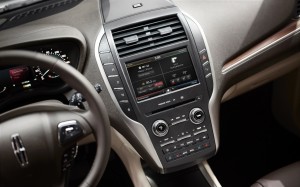
photo courtesy Lincoln
Start the engine and clusters of blank buttons below the touchscreen light up with icons for climate control and select audio controls. Speaking of climate control, the MKC heats the rear seats, too.
The parking brake lever is a little inconvenient to reach, sitting as it does almost under the dash to the left of the steering wheel.
Hockey bag test
Cargo room isn’t an issue in the MKC. This picture shows room for a second bag.. The split-folding rear seats are up.
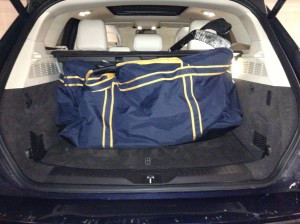
In-car technology
An enhanced THX II audio system uses nine speakers to envelop occupants with fantastic sound.
SYNC 3, the company’s latest, QNX-fueled stab at in-car controls via touchscreen, has improved over its previous Microsoft-based incarnation. Larger icons make mis-touches less likely on the capacitive 8-inch LCD touchscreen.
Six icons representing frequently-used technologies reside at the bottom of every screen in an area Mac users know as the dock. The default home screen splits itself into navigation information, what’s on the audio system and details from the phone that’s hooked up to the vehicle. Those details include status of the phone’s battery, something drivers can top up using one of the two smart-charging USB ports.
One subtle touch impressed me with its thoughtfulness: when you turn on the lights, the touchscreen changes colours to better match the lighting coming in from outside. Drivers can also choose the background colour for the screen.
An optional embedded modem lets owners communicate with the the vehicle remotely via the MyLincoln Mobile app. This is a good idea: I’ve always preferred interacting with screens outside a vehicle over doing so once in the drivers seat. Depending on the model and the stage of development, drivers ought to be able to do things like set new routes and send them to their vehicles from phones, tablets or computers so they don’t need to fuss as much with the technology right before they roll.
The MKC continues to feature AppLink, and it can work well, but it means more work for both the driver and Lincoln to get legitimate apps to work here. Automakers would be better off if their AppLink-type systems ceded their places to CarPlay or Google Auto. Let the mobile OS manufacturers decide which apps should work in a vehicle. There’s no sense in automakers curating apps when Apple and Google can do this for more effectively from their own stores and operating systems.
Driving
My MKC tester gets its “vamonos” from 2.0-litre inline 4-cylinder GTDI Ecoboost engine built in Valencia, Spain before being transported to the Louisville, KY assembly plant. More-than-adequate maximums of 240 hp and 270 lb-ft of torque can be exceeded by drivers who opt for the available 2.3-litre engine, which boosts those numbers to 285 and 305, respectively. Lincoln offers a class II trailer tow package.
Lincoln supplements the full gamut of safety features owners would expect with available driver-assist technology like a lane-keeping system, a blind-spot information system and active park assist.
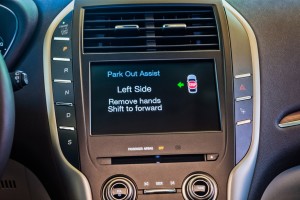
photo courtesy Lincoln
Models with the the 2.0-litre engine are available with either FWD or AWD, while 2.3-litre variants are exclusively AWD. In either case, the MKC takes 87 octane fuel in its 60-litre tank.
Conclusions
The “S” button below “D” lets you control the 6-speed automatic using steering-wheel-mounted paddle shifters. I can’t see many Lincoln buyers opting to use these shifters. The MKC is a competent city vehicle that comes into its own on highway jaunts, keeping engine and wind noise at bay and occupants comfortably coddled while they speed along. In other words, it’s a Lincoln.
Pricing
The base MKC will set buyers back $39,940 plus extras. My tester, as equipped, lists for $50,475.